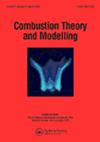Numerical study on three-stage ignition of dimethyl ether by hot air under engine-relevant conditions
IF 1.6
4区 工程技术
Q4 ENERGY & FUELS
引用次数: 0
Abstract
AbstractNon-premixed combustion often occurs in practical engines, and it is affected by the coupling effects of chemical kinetics and transport. This study aims to elucidate the individual effect of chemical kinetics, molecular diffusion, and convective transport on non-premixed combustion. To this end, three types of reactive systems are investigated by numerical simulations considering detailed chemistry and transport: (1) thermochemical system: 0D homogeneous autoignition, (2) thermochemical-diffusive system: 1D non-premixed ignition in a static diffusion layer, (3) thermochemical-diffusive-convective system: 1D non-premixed ignition in a counterflow and 2D lifted flame in a coflow. The simulations are carried out for diluted dimethyl ether and hot air under engine-relevant conditions with a pressure of 40 atm and hot air temperatures of 700∼1500 K. First, homogeneous ignition process of DME/air premixture is investigated. It is found that, apart from the low- and high-temperature chemistry which are essential in the typical two-stage ignition, the intermediate-temperature chemistry can also play an important role, especially for slow reaction process in fuel rich regions. Then, the effects of thermochemical conditions and molecular diffusion are assessed for non-premixed ignition process in the 1D diffusion layer. The results show that, the reaction front always initiates from local autoignition in most reactive regions; then it propagates either in sequential auto-ignition mode or in diffusion-driven mode as a deflagration wave. With various thermochemical conditions, the chemical kinetics behave differently and produce complex multibrachial (tetrabrachial, pentabrachial and hexbrachial) structures during the reaction front propagation. Decreasing the diffusion layer thickness generally delays the reaction front initiation but enhances its transition into a diffusion-driven flame. Finally, it is shown that 1D diffusion layer simulations can qualitatively reproduce the complex multibrachial structures in 1D counterflow and 2D coflow at certain conditions. A regime diagram is proposed to separate the effects of chemical kinetics, molecular diffusion, and convective transport.Keywords: non-premixed combustiondimethyl etherthree-stage ignitionintermediate-temperature chemistry Disclosure statementNo potential conflict of interest was reported by the author(s).Supplemental dataSupplemental data for this article can be accessed here https://doi.org/10.1080/13647830.2023.2261423.Additional informationFundingThis work is jointly supported by the National Natural Science Foundation of China (Nos. 52176096 and 51861135309) and the German Research Foundation (DFG, no. 411275182).发动机相关条件下二甲醚热空气三级点火的数值研究
摘要非预混燃烧在实际发动机中经常发生,它受到化学动力学和输运耦合效应的影响。本研究旨在阐明化学动力学、分子扩散和对流输运对非预混燃烧的个别影响。为此,通过数值模拟研究了三种类型的反应系统,考虑了详细的化学和输运:(1)热化学系统:0D均匀自燃;(2)热化学扩散系统:静态扩散层中的一维非预混点火;(3)热化学扩散对流系统:逆流中的一维非预混点火和共流中的二维提升火焰。在与发动机相关的条件下,对稀释二甲醚和热空气进行了模拟,压力为40 atm,热空气温度为700 ~ 1500 K。首先,研究了二甲醚/空气预混料的均匀点火过程。研究发现,在典型的两级点火过程中,除了低温和高温化学反应外,中温化学反应也起着重要的作用,特别是在富燃料地区的慢反应过程中。然后,评估了热化学条件和分子扩散对一维扩散层中非预混点火过程的影响。结果表明:在大多数反应区,反应前沿都是从局部自燃开始的;然后以顺序自燃模式或扩散驱动模式作为爆燃波传播。在不同的热化学条件下,化学动力学表现不同,在反应前沿传播过程中产生复杂的多臂(四臂、五臂和六臂)结构。减小扩散层厚度通常会延迟反应锋面的起始,但会促进其向扩散驱动火焰的转变。结果表明,在一定条件下,一维扩散层模拟可以定性再现一维逆流和二维共流中的复杂多臂结构。提出了一个状态图来分离化学动力学、分子扩散和对流输运的影响。关键词:非预混燃烧二甲醚三级点火中温化学披露声明作者未报告潜在利益冲突。补充数据本文的补充数据可在此获取https://doi.org/10.1080/13647830.2023.2261423.Additional information。基金资助:国家自然科学基金项目(no. 52176096和51861135309)和德国研究基金项目(DFG, no. 1135309)。411275182)。
本文章由计算机程序翻译,如有差异,请以英文原文为准。
求助全文
约1分钟内获得全文
求助全文
来源期刊

Combustion Theory and Modelling
工程技术-工程:化工
CiteScore
3.00
自引率
7.70%
发文量
38
审稿时长
6 months
期刊介绍:
Combustion Theory and Modelling is a leading international journal devoted to the application of mathematical modelling, numerical simulation and experimental techniques to the study of combustion. Articles can cover a wide range of topics, such as: premixed laminar flames, laminar diffusion flames, turbulent combustion, fires, chemical kinetics, pollutant formation, microgravity, materials synthesis, chemical vapour deposition, catalysis, droplet and spray combustion, detonation dynamics, thermal explosions, ignition, energetic materials and propellants, burners and engine combustion. A diverse spectrum of mathematical methods may also be used, including large scale numerical simulation, hybrid computational schemes, front tracking, adaptive mesh refinement, optimized parallel computation, asymptotic methods and singular perturbation techniques, bifurcation theory, optimization methods, dynamical systems theory, cellular automata and discrete methods and probabilistic and statistical methods. Experimental studies that employ intrusive or nonintrusive diagnostics and are published in the Journal should be closely related to theoretical issues, by highlighting fundamental theoretical questions or by providing a sound basis for comparison with theory.
 求助内容:
求助内容: 应助结果提醒方式:
应助结果提醒方式:


